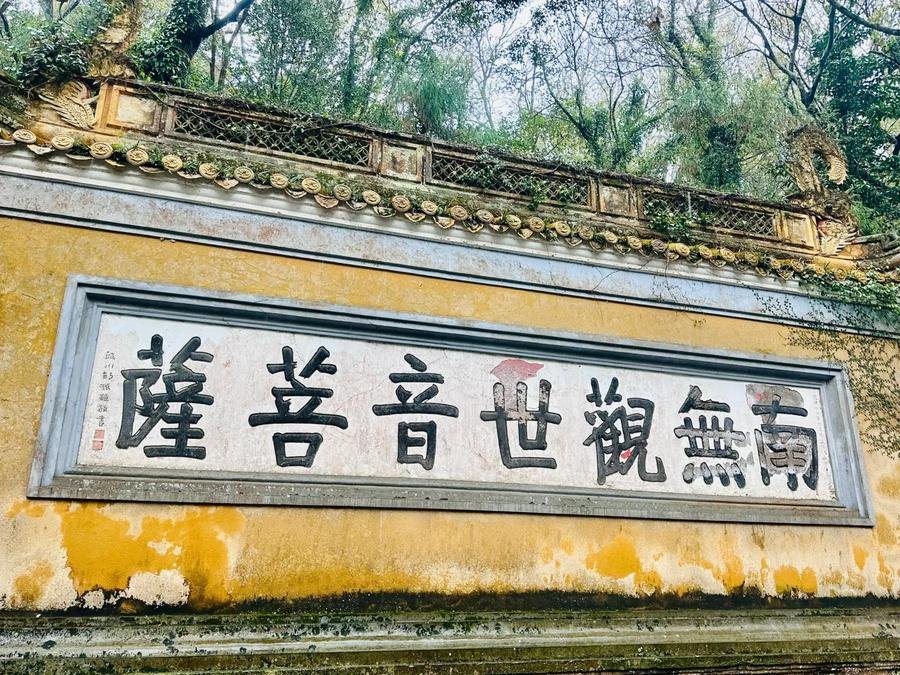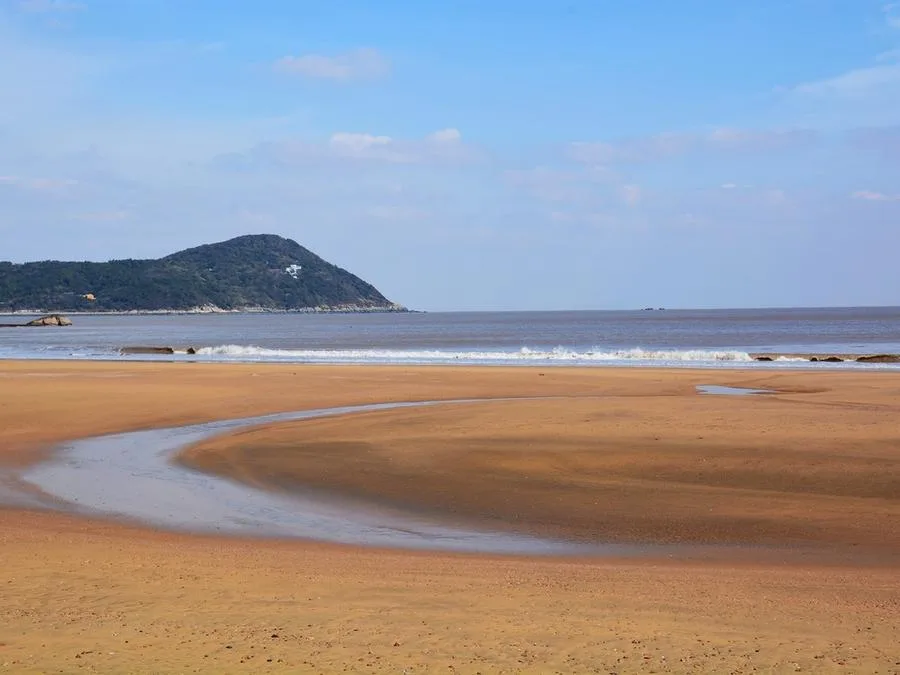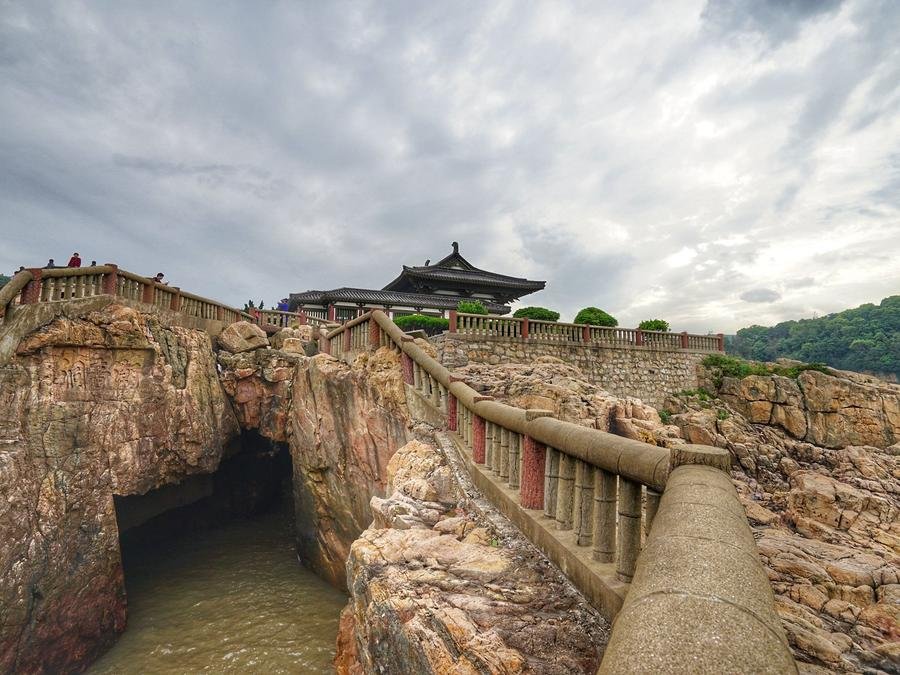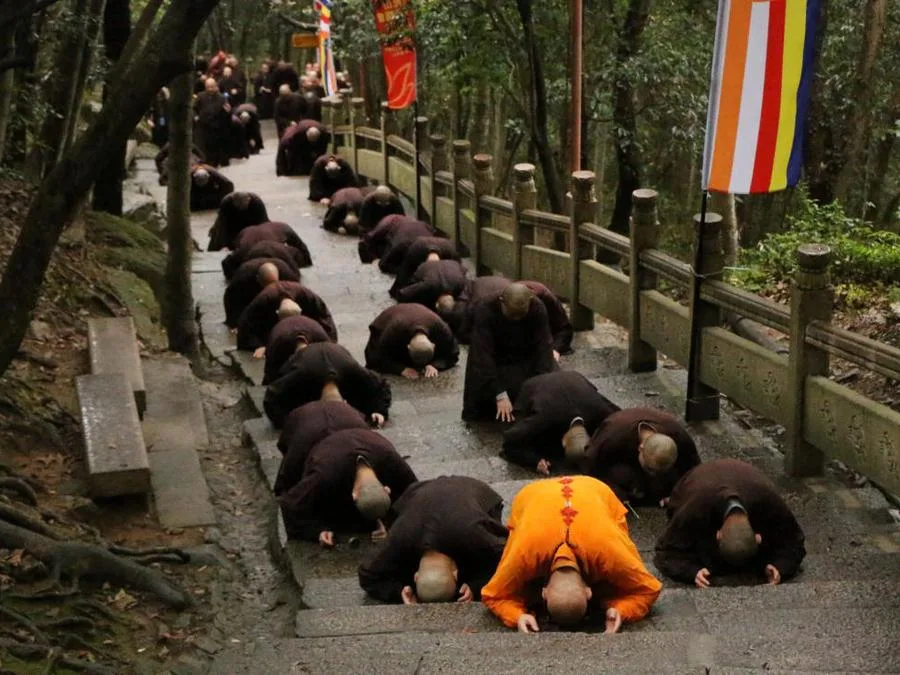Putuo Mountain Scenic Area (普陀山风景名胜区, Mount Putuo) is located in Zhoushan, Zhejiang Province, and is renowned as a sacred site dedicated to the Bodhisattva Guanyin. The island, which is elongated in shape, is often referred to as the “Buddhist Kingdom in the Sea and Sky” due to its profound religious significance and picturesque coastal landscape. Throughout the year, countless devotees visit the island to seek blessings from Guanyin.
Putuo Mountain boasts an extensive array of Buddhist architecture, with many structures dating back to ancient times. The island’s three major temples – Puji Temple, Fayu Temple, and Huiji Temple – along with 56 monasteries and 16 thatched huts, form a well-preserved cultural landscape of Guanyin worship from the Ming and Qing dynasties. The interconnected Lotus Incense Path further enhances the spiritual ambiance of the area.
The ancient architecture on Putuo Mountain is organized into three main zones based on their overall layout: Front Mountain Area: Centered around Puji Temple, this area serves as the main site for Buddhist activities on the island. Surrounding Puji Temple are 12 other temples and various structures; Middle Mountain Area: Dominated by Fayu Temple, this zone includes 10 additional temples, creating a significant cluster of religious buildings. Foding Mountain Area: Huiji Temple is the principal temple in this zone. Due to the limited flat land and challenging material supply on the mountain top, there has been minimal expansion of additional buildings.
Table of Contents
- Basic Information
- Location and Transportation
- Highlights of Putuo Mountain
- Vlog about Putuo Island
- Evolution of Mount Putuo’s Name
- Attractions near Putuo Mountain
Basic Information
| Estimated Length of Tour | 1 – 2 days |
| Ticket Price | 160 RMB |
| Round Ferry Trip | 60 RMB |
| Opening Hours | 6.30 – 21.50 |
| Famous Spots | Fayu Temple, Puji Temple, Duobao Pagoda, Huiji Temple |
| Best Time to Visit | Spring and Autumn |
| Area | 41.95 square kilometers |
| Telephone Number | 0086-0580-3191919 0086-0580-3889090 |
Location and Transportation
Putuo Mountain Scenic Area is located approximately 100 nautical miles east of Hangzhou Bay, Zhejiang Province. The geographical coordinates are between 29°58′3″ to 30°02′3″ north latitude and 122°21′6″ to 122°24′9″ east longitude. It is situated 6.5 kilometers southwest of Shenjiamen Fishing Port and 2.5 kilometers south of Zhujiajian Island, bordered by the vast sea to the east.
How to Get There: Putuo Mountain is not accessible by road and can only be reached by ferry. The primary access points are:
- Shenjiamen Banshendong Wharf ⇄ Putuo Mountain Wharf:
- This route operates several high-speed ferries, with departures every 30 minutes or less.
- Shenjiamen Duntou Wharf ⇄ Putuo Mountain:
- One ferry operates on this route, with two daily round trips.
- Departure times from Shenjiamen Duntou: 08:50 and 12:40.
- Return times from Putuo Mountain: 11:55 and 14:50.
Transportation on Putuo Mountain: Two main tourist bus lines connect most of the scenic spots on the island:
- Line 1:
- Stops include Baibusha (Puji Temple), Baibu Pavilion, Purple Bamboo Forest, Entering Samadhi, Wharf, Haifang New Village, Seafood Garden, Baotuo Hotel, and Xitian Ferry (this line may be suspended during major holidays and incense festivals).
- Line 2:
- Stops include Baibusha (Puji Temple), Chaoyang Cave, Dasheng Nunnery, Fayu Temple, Feisha’ao, Baoyue Nunnery, Ancient Buddha Cave, and Cable Car Station.
Highlights of Putuo Mountain
Nanhai Guanyin Statue

The Nanhai Guanyin Statue (南海观音立像), also known as the Great Buddha of South Sea Guanyin (南海观音像大佛), is an iconic landmark standing 33 meters tall. The statue’s base measures 13 meters, with the bronze figure itself standing at 18 meters, atop a 2-meter lotus pedestal. Weighing over 70 tons, the statue’s base houses a merit hall spanning over 1,000 square meters. The upper floor of this hall is dedicated to 500 unique bronze statues of Guanyin, while the lower hall features large boxwood carvings depicting mystical stories of Guanyin and colorful jade reliefs showcasing the scenic beauty of Putuo Mountain.
Constructed by the Luoyang Bronze Processing Plant in Henan Province, the statue adopts the image of Guanyin as the Sea-Contemplating Bodhisattva. This representation is marked by a compassionate and serene expression, capturing a divine and majestic appearance. The statue is crafted from gold-plated bronze, consisting of 96 copper panels, with the face of the Buddha incorporating 6,500 grams of gold. The location of the Nanhai Guanyin Statue is historically significant, situated at Longwan Gangdun, the very site where the Japanese monk Hui’e left the “Not-Willing-to-Go Guanyin” statue on the Shinra Reef.
Puji Temple

Puji Temple (普济寺), also known as the Front Temple, is one of the three major temples on Putuo Mountain, located in the Putuo District of Zhoushan City, at the southern foothills of Lingjiu Peak on Baihua Peak. Established in the second year of Zhenming during the Later Liang Dynasty (916 AD), the temple covers an area of 26,000 square meters and faces south.
The temple’s main axis is lined with ancient structures, including the Imperial Stele Hall, the Hall of Heavenly Kings, the Hall of Guanyin (Yuantong Hall), and the Sutra Library. The overall layout of Puji Temple follows the traditional central axis method while cleverly utilizing the surrounding terrain to arrange the individual buildings. This design showcases unique architectural ingenuity and represents a culmination of Qing Dynasty architectural style, making Puji Temple a quintessential example of official-style architecture from that period in Zhejiang Province.
Fayu Temple

Fayu Temple (法雨禅寺), originally built during the Ming Dynasty, is another major highlight of Guanyin Temple. Nestled against the mountains and layered with ancient trees, Fayu Temple, also known as the Rear Temple, was initially named Haichao’an (Sea Tide Hermitage). In the 38th year of the Kangxi era of the Qing Dynasty, the temple received the imperial plaque inscribed with “Tianhua Fayu,” thereafter becoming known as Fayu Zen Temple.
The most magnificent feature of Fayu Temple is the Nine-Dragon Hall, which was transported in its entirety from the Ming Palace in Nanjing. This hall is recognized as the highest standard of Buddhist temple architecture in China. Inside, the hall houses the Nine-Dragon Ceiling, one of the three treasures of the Putuo Mountain Scenic Area. This intricately crafted ceiling is a masterpiece of fine art, vividly detailed and of immense artistic value, recognized as a national treasure.
Huiji Zen Temple

Huiji Zen Temple (慧济禅寺), also known as Fodingshan Temple, is situated at the highest point of Putuo Mountain in the scenic area. The layout of the entire temple is unique, unlike most other Zen temples. Behind the Hall of Heavenly Kings, the main structures, including the Mahavira Hall, the Hall of Great Compassion, the Sutra Library, the Hall of the Jade Emperor, and the Abbot’s Room, are all aligned on a single parallel line. This design showcases the architectural style of eastern Zhejiang gardens.
The main hall of Huiji Temple is the Mahavira Hall, which enshrines a statue of Shakyamuni Buddha. The Hall of Great Compassion, located on the right, houses a Tang Dynasty statue of Guanyin, which is the oldest Buddhist statue in the Putuo Mountain Scenic Area. The roof of the main hall is adorned with glazed tiles in shades of sky blue, light green, pale yellow, and purple-red. Under the sunlight, the tiles reflect a myriad of colors, creating a stunning “Buddha’s light” effect, symbolizing the enlightenment that pervades the temple.
Zhulin Temple

Zhulin Temple (竹林庵) is located south of Baibusha and west of Chaoyin Cave, directly facing the sparkling waters of Lotus Pond and overlooking Luojia Mountain across the sea. The temple is nestled against the mountain and faces the sea, featuring a simple and elegant design. The temple’s name plaque, “补袒紫竹林 (Putuo Purple Bamboo Forest),” was personally inscribed by Kang Youwei, a renowned modern Chinese thinker.
The main hall of Zhulin Temple houses a white marble statue of Guanyin, known as the Purple Bamboo Guanyin. The statue portrays Guanyin in various forms, symbolizing the diverse ways in which the bodhisattva manifests to save sentient beings and inspire kindness and compassion.
Bukenqu Guanyin Temple

Bukenqu Guanyin Temple (Unwilling-to-Leave Guanyin, 不肯去观音院) is the historical site where Master Huier initially enshrined the “Unwilling-to-Leave Guanyin” statue. This temple is the birthplace of the Guanyin worship tradition in the Putuo Mountain Scenic Area. Inside the temple, there is a statue of an eleven-faced Guanyin in the Tang Dynasty style. To the west of the temple, a corridor called the “33 Guanyin Shrine Sites” is built, featuring statues representing the main deities of 33 Guanyin temples in Japan.
Yueling Nunnery

Yueling Nunnery (悦岭庵) currently serves as the Putuo Mountain Scenic Area Cultural Relics Museum. The museum houses over 1,000 precious artifacts from various temples on the mountain. Key exhibits include an imperial decree from the Ming Dynasty Wanli period, purple cassocks bestowed by Qing emperors Kangxi and Qianlong, a bronze screen with Japanese Buddhist figures, an ancient Sanskrit palm-leaf manuscript from India, jade Buddhas from Myanmar, and a vast collection of ancient bronzes, porcelain artifacts, renowned calligraphy and paintings, and artistic Buddha statues. This museum encapsulates the rich historical and cultural heritage of the entire Putuo Mountain Scenic Area.
Yangzhi Nunnery

Yangzhi Nunnery (杨枝庵), established during the Ming Dynasty’s Wanli period, has been a treasured site for over 300 years, housing one of Putuo’s three most prized artifacts: the Yangzhi Guanyin Stele, painted by the renowned Tang Dynasty artist Yan Liben. The stele stands 2.3 meters tall and depicts the bodhisattva in a regal pose, adorned with a jeweled crown and a richly decorated robe. She holds a purification vase in her left hand and a willow branch in her right, radiating an aura of serene majesty. Yan Liben’s artwork is exceptionally rare, and this particular piece is the only known surviving Buddhist figure painting by him, making it an invaluable cultural relic.
Duobao Pagoda

The Duobao Pagoda (多宝塔), also known as the Prince Pagoda, is an architectural masterpiece from the Yuan Dynasty. This five-story, 18-meter-high square pagoda is constructed from beautiful Taihu Lake stones. The corners of the pagoda are adorned with statues of the Four Heavenly Kings, and the railings feature intricate carvings of the twenty-four manifestations of Guanyin. Below the railings, twenty dragon heads are carved, adding to the structure’s elaborate design. The third tier of the pagoda is intricately carved with ancient Buddha images on all four sides, blending Yuan Dynasty architectural style with the unique characteristics of the Guanyin worship tradition in the Putuo Mountain Scenic Area. The Duobao Pagoda is a national cultural relic, and the melodious chime of its bell is celebrated as one of Putuo’s twelve scenic wonders.
Luojia Mountain

Luojia Mountain (洛迦山) is located southeast of the Putuo Mountain Scenic Area, rising majestically above the waters of the Lotus Ocean, resembling a reclining Buddha. The mountain is lush with verdant trees and dotted with numerous temples and monasteries. It is traditionally believed to be the earliest site where Guanyin Bodhisattva practiced, leading to the saying that a pilgrimage to Putuo Mountain is incomplete without visiting Luojia Mountain. This sacred site is also one of Putuo’s twelve famous scenic spots, known as Luojia Holy Mountain.
Hundred-Step Beach and Thousand-Step Beach

Hundred-Step Beach (百步沙), also known as Taqian Beach, is affectionately called the Lion’s Tail due to its unique shape. It is surrounded by stunning rock formations, with a prominent boulder known as the Master’s Stone standing tall by the sea.
Thousand-Step Beach (千步沙) stretches from Chaoyang Cave in the south to Fayu Temple in the north, spanning 1500 meters. The sand here is exceptionally fine and clean. During the summer and autumn seasons, the beach witnesses impressive waves crashing ashore, creating a breathtaking spectacle. At night, the sea offers a mesmerizing view with waves that glisten in the dark, a phenomenon known as “sea fire” or “divine fire” by the faithful. Today, both Hundred-Step Beach and Thousand-Step Beach serve as excellent spots for seawater bathing and beach activities, attracting tourists who enjoy sea views and water sports.
Ancient Tide Cave and Brahma Sound Cave

Brahma Sound Cave (梵音洞): Situated at the far end of the Qinggulei area in the Putuo Mountain Scenic Area, Brahma Sound Cave stands impressively at over 80 meters high and 3 to 6 meters wide. The two cliffs on either side split like a gateway, with a massive rock embedded in the middle. From the Zhan Sheng Pavilion, visitors can view the Brahma Sound Cave, where the rocks exhibit vibrant colors in the mist. The cave is known for its majestic and steep walls, making it a prominent and unique natural feature.
Tide Sound Cave (潮音洞): Located in the Purple Bamboo Forest area, Tide Sound Cave extends into the sea with cliff walls reaching over 50 meters high and 3 to 5 meters wide. Inside, the cave features jagged rock formations, and the sound of waves crashing against the rocks is as loud as thunder, creating a stunning natural spectacle with cascading waterfalls and splashing water. It is believed that Guanyin Bodhisattva manifested various precious forms in this cave, making it a site of great spiritual significance. Both caves, with their resounding tide sounds, are considered two of the twelve famous scenic spots in Putuo.
Guanyin Pilgrimage Festival

The Guanyin Pilgrimage Festival (观音香会节), also known as the “Three Major Guanyin Incense Festivals of Putuo Mountain,” occurs on three significant dates: the 19th day of the second lunar month, the 19th day of the sixth lunar month, and the 19th day of the ninth lunar month. These dates are celebrated as Guanyin Bodhisattva’s birthday, enlightenment day, and ordination day (or nirvana day), respectively. These festivals have become traditional Buddhist events in China.
During these incense festivals, Putuo Mountain experiences a surge of devotion, with domestic and international devotees flocking to the mountain. On the 18th, the three major temples conduct solemn Buddha and Guanyin ceremonies, attracting thousands of monks and devotees. In the evening, thousands gather inside and outside the Yuan Tong Hall to chant the Great Compassion Mantra of Guanyin Bodhisattva.
The following morning, the gates of Puji Temple open to welcome a flood of pilgrims who make their way to Foding Mountain. From Fayu Temple’s Nine Dragons Hall to the incense cloud path with its thousand stone steps, devotees climb, kneeling at each step, in a display of deep reverence and piety. This spectacle is profoundly moving and spiritually enlightening. On the 19th at noon, all temples and nunneries offer grand meals led by the abbots, followed by evening prayer ceremonies. During this time, the temples are illuminated with candles, and the chanting of Buddhist scriptures continues throughout the night, creating a solemn and sacred atmosphere.
Vlog about Putuo Island
Evolution of Mount Putuo’s Name
Originally known as Meicen Mountain, Putuo Mountain’s initial name stemmed from the legend of Mei Fu, who practiced Taoism there during the late Western Han Dynasty. This historical background gave the mountain its earliest name.
In the Tang Dynasty, during the fourth year of the Xiantong era (863 AD), the Japanese monk Hui’e obtained a statue of Guanyin from Mount Wutai and intended to bring it back to Japan. However, when his ship encountered turbulent waves in the Lotus Sea, he interpreted this as a sign that Guanyin did not wish to leave China. Consequently, he left the statue on the island, which became known as the “Not-Willing-to-Go Guanyin.”
In the Later Liang Dynasty of the Five Dynasties period, during the second year of the Zhenming era (916 AD), a temple was built to honor this statue, known as the “Not-Willing-to-Go Guanyin Temple.” This event marked a significant development in the religious significance of the area.
During the Song Dynasty, in the third year of the Yuanfeng era (1080 AD), the imperial court granted funds to reconstruct the temple, renaming it the Baotuo Guanyin Temple. This act further increased the temple’s prominence, and by the seventh year of the Jiading era in the Southern Song Dynasty (1214 AD), it was officially designated as a site for Guanyin worship. The mountain was then renamed Putuo Luojia Mountain, deriving from the Buddhist term “Potalaka,” which is the mythical abode of Guanyin.
In the Ming Dynasty, a small island to the south of the Lotus Sea was named Luojia Mountain. This led to the coexistence of two distinct names: Putuo Mountain and Luojia Mountain. Over time, the name Putuo Mountain became more widely recognized and is now synonymous with this sacred site dedicated to Guanyin worship.





